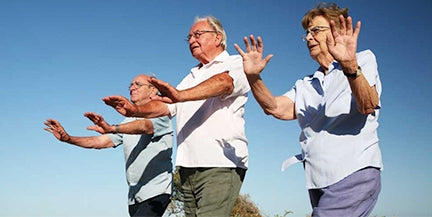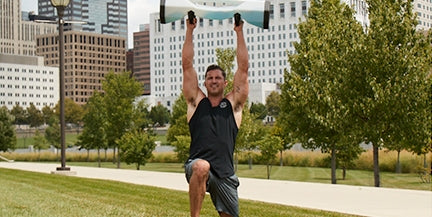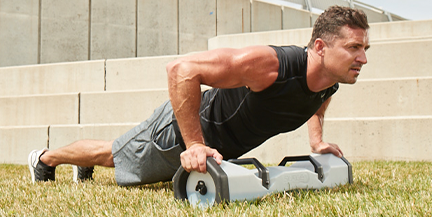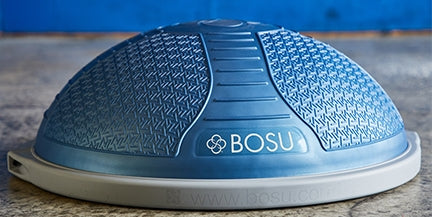BOSU® Balance Exercises Can Improve Your Memory & Much More!

Working on balance and stability is something we should be incorporating into our exercise routines at all ages. However, balance is often a necessity we take for granted until we notice how lack of balance can affect our daily life and everyday enjoyments.
As we age, balance abilities may decline and safety can become compromised as we are more susceptible to falls, our confidence gets rattled, and we stop participating in previous activities we enjoyed. Research is now showing that a lack of balance is also connected to a higher risk of cognitive decline.
Memory
The brain and body connection is strong. Our brains are constantly receiving feedback from our eyes (visual system) and our inner ears (vestibular system), as well as muscles and joints (somatosensory system). Any changes in these systems will lead to changes in our abilities to balance. Specifically, changes to the vestibular systems has shown changes in the hippocampus, associated with our long term memory.
What is the correlation between balance and memory? The proprioceptive systems involved with balance must be worked and challenged just like we do with our muscular and cardiorespiratory systems. Changes in these proprioceptive systems reduce our ability to balance and have greater potential to affect our memory. We can trigger these systems as we exercise with balance training to limit the adverse effects of aging.
In the same way that we focus on cardiorespiratory fitness and muscular strength / endurance, we need to focus on incorporating balance into our routines for overall fitness.
Exercise
Exercise is important at every age but it is especially important for active agers. Adults can lose muscle mass at a potential rate of 3% – 5% every decade. We can fight back and reduce this loss with consistent strength training. The lack of activity and plethora of convenience as everything is at our fingertips, are strong contributors to loss of muscle over the decades.
Exercise also plays a key role in neuroplasticity, the ability to form new neural connections. Challenging the brain with balance type exercises promotes generation of these neural pathways. In the past, research has shown how exercise can enhance neuroplasticity and now is pointing toward improvements in learning and memory, as well as delays in Alzheimer's disease.
Overall, exercise and balance training will always be key components to memory and cognitive health.
Active Aging
Aging is a beautiful thing. Really it is! There is a lot to be celebrated with each year we are alive, breathing, and experiencing what gives us joy. While we have learned the importance of balance as it pertains to our cognitive health, there are many other benefits.
Balance is the foundational skill for any type of movement. It all starts with this building block skill. Every step requires balance to get from point A to point B. Create better balance and you will be adding more of the following into your life:
Safety
Falls and the injuries that follow can be common with active agers. Improve your balance and stability and reduce your risk of falls and injuries.
Confidence
Feel more confident while walking, running, dancing, or participating in a yoga class. With confidence the sky's the limit and you are in the driver's seat heading toward what makes you happy.
Proprioception
This is awareness of your body's position in space. A decrease in proprioception can lead to abnormal joint biomechanics leading to degenerative joint disease. Improve your proprioception and your everyday quality of movement will allow you to do what you love.
Tips When Adding Balance Work
- Start slowly and with smaller movements. Get acclimated with the move first and then progress to larger movements.
- Use assistance. If a move is challenging or could compromise your safety, move your BOSU® Balance Trainer near a wall and utilize a contact point to use to stabilize yourself until you gain confidence and improve your balance.
- Clear your space. Before beginning make sure your workout space is clear of items you might trip over.
- Don’t get discouraged. Change happens when you are training outside your comfort zone. Don’t expect to be able to master a skill right away.
- Be consistent. Balance exercises can be performed as often as you would like. To begin, aim for 3 or more days a week.
Exercises to Improve Balance
Get out your BOSU® Balance Trainer and start improving your balance with these exercises!
Kneeling Balance with Rotation
Begin kneeling on the dome of the BOSU® Balance Trainer with the toes of both feet on the ground. Lift one arm up by the ear and rotate to the same side. Repeat with the opposite arm in the other direction. The goal is to maintain as much postural stability as possible and to keep the hips forward. Progress this move by lifting the toes on one foot from the floor. Challenge yourself further but lifting the toes of both feet off the floor. Repeat for 10 reps, with one rotation to each side counting as one rep.
Biased Stand Knee Raise
This one is all about control! The challenge of standing on one foot can be deceiving. Adding on the complexity of a twist with visual tracking adds another layer to this exercise. Begin with one foot on the dome of the BOSU® Balance Trainer. Lift the arms over head as you lift the foot off the dome and balance for a few seconds. Lower the foot back to the dome. Open one arm at a time to the side, tracking the hand with your eyes. Repeat for 10 reps before moving over the dome to the opposite side.
Hinge Toe Raise
This is a must try if you want to work on your balance but feel more confident being closer to the floor. Start kneeling on the dome with toes on the floor. With a flat back, hinge forward and touch fingertips to the front to the dome. As you raise the chest back up to start position, simultaneously lift the toes off the floor. Try one slow and add speed as you become more confident. Repeat for 10 reps.
Becky Ingebrigtsenhas a degree in Exercise and Sports Science from the University of Wisconsin, and is the owner of A & B Fitness Concepts fitness studio. She is a college instructor, blogger and BOSU® Master Trainer.
Learn, train and engage with other fitness professionals at BOSU® Live Education courses. For information on our cutting edge content, taught by the best in the industry, click HERE.
References:
Brain Plasticity. 2018; 4(1): 95–110.
Published online 2018 Dec 12. Pre-published online 2018 Sep 3. doi: 10.3233/BPL-180073.
Retrieved from-https://www.ncbi.nlm.nih.gov/pmc/articles/PMC6296269/
Apec Brain Center(January 2015) Retrieved from
https://apexbraincenters.com/2015/01/29/how-balance-affects-brain-health/



